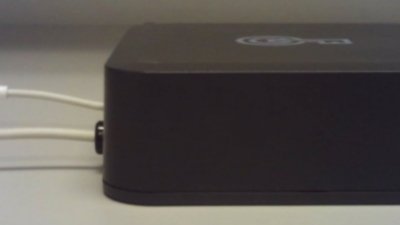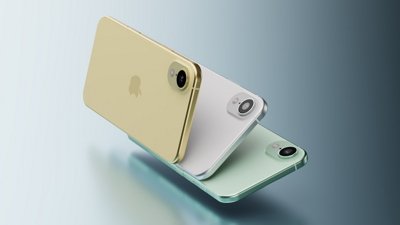Despite comments from Apple executives that the company would have no part in bringing the 802.11a WiFi specification over to the Macintosh, the first Intel-based Macs announced this week have the capability to connect to third party access points using the standard, AppleInsider has confirmed.
Once touted as a likely successor to the 802.11b standard, the 802.11a specification hit insurmountable roadblocks a few years ago when WiFi manufacturers largely began favoring the the 802.11g specification instead because of its backwards compatibility with 802.11b networks.
"802.11a makes no sense— no sense at all," Greg Joswiak, Apple's vice president of worldwide hardware product marketing, said almost three years ago to the day. "There's no conceivable (802.11)a market."
Because 802.11a is not backwards compatible, users transitioning from 802.11b would be forced to abandon their networks and buy new access points and wireless laptop cards — an expense that could turn monstrous depending on depending on the size of the network. Hefty consumer expenses associated with transitioning to 802.11a was also the primary reason Joswiak cited for Apple's decision to pass on the standard.
The 802.11a specification differs from others in that it provides 12 non-overlapping channels — 8 for indoor use — that enable more access points to cover same physical location without interfering with one another.
Users of Apple's new iMac Core Duo and MacBook Pro will have the capability to browse and connect to third party access points using 802.11a (as well as 802.11b and 802.11g). However, Apple has told its partners that it will not be providing any further support for the standard at this time. Additionally, neither Apple's AirPort Express nor AirPort Extreme wireless access points currently support 802.11a.
Still, that didn't stopped the company from taking advantage of the implementation the first chance it got. According to tipsters, Apple vice president Phil Schiller used a 802.11a wireless network for a MacBook Pro product demonstration during company's opening keynote address at this week's Macworld Expo. This reportedly allowed Schiller to avoid the connection quagmire experienced by the hundreds of laptop users connected to the 802.11g network in the keynote hall.
It's unclear if Apple will decide to add support for 802.11a to its AirPort wireless access points sometime in the future. The company's new iMac Core Duo desktop featuring 802.11a support is currently shipping, while its MacBook Pro laptop offering is not expected to ship in volume until sometime next month.
 Katie Marsal and Kasper Jade
Katie Marsal and Kasper Jade






-m.jpg)






 Malcolm Owen
Malcolm Owen
 Wesley Hilliard
Wesley Hilliard
 Marko Zivkovic
Marko Zivkovic
 Christine McKee
Christine McKee



 Amber Neely
Amber Neely









44 Comments
Seem they decided to finally give in to people begging to be able to access the 802.11a networks. Ultimately I don't know of any wireless A networks myself. I'm running 802.11g like 95% of people now and it would make no sense to include support in their routers if they already support G simply because anyone broadcasting 802.11a is probably a dumbass.
Seems they must be using Intels wireless chipset solution as it has support for 802.11a/b/g. I was wondering with the switch would apple use Intels hardware chipsets (..Smart), or would they fashion their own in-house approach. Hopefully over time, this brings cost down, and enables Apple to stay on the cutting edge in incorporating new technology. This may also explain the lack of firewire-800 on the new MacBooks as I'm not sure Intel has a chipset to support this?
Seems they must be using Intels wireless chipset solution as it has support for 802.11a/b/g. I was wondering with the switch would apple use Intels hardware chipsets (..Smart), or would they fashion their own in-house approach. Hopefully over time, this brings cost down, and enables Apple to stay on the cutting edge in incorporating new technology. This may also explain the lack of firewire-800 on the new MacBooks as I'm not sure Intel has a chipset to support this?
Actually, my interpretation of the article's content states that OS X 10.4.4 now has low-level support for the 802.11a standard but the MacBook Pro and new iMac both use Airport Extreme which uses the 802.11a/g cards.
Meanwhile, Schiller had a custom added wifi card for the purposes of the Keynote which allowed him to have low bandwidth saturation during his part of the keynote.
So they ditched Broadcom?
"Users of Apple's new iMac Core Duo and MacBook Pro will have the capability to browse and connect to third party access points using 802.11a (as well as 802.11b and 802.11g). However, Apple has told its partners that it will not be providing any further support for the standard at this time. Additionally, neither Apple's AirPort Express nor AirPort Extreme wireless access points currently support 802.11a."
This paragraph says that neither the airport express or extreme ACCESS POINTS support 802.11a. The new iMac and MacBook do have 802.11a support... seems clear enough.